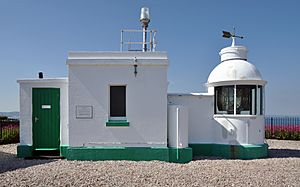Berry Head Lighthouse facts for kids
 |
|
| Berry Head Lighthouse | |
|
|
|
| Location | Brixham Devon England |
|---|---|
| Coordinates | 50°23′58.5″N 3°29′0.4″W / 50.399583°N 3.483444°W |
| Year first constructed | 1906 |
| Automated | 1921 |
| Tower shape | cylindrical lantern with dome attached to equipment building |
| Markings / pattern | white lantern and dome |
| Height | 5 m (16 ft) |
| Focal height | 58 m (190 ft) |
| Original lens | 500 mm 3rd order rotating optic |
| Current lens | LED |
| Range | 18 nmi (33 km; 21 mi) |
| Characteristic | Fl (2) W 15s. |
| Admiralty number | A0244 |
| NGA number | 0344 |
| ARLHS number | ENG 007 |
The Berry Head Lighthouse is an active lighthouse found at the very tip of Berry Head. This spot is close to Brixham in Devon, England. It was first built in 1906 to help ships find their way safely.
Over the years, the lighthouse has been updated many times. In 1921, it became automated, meaning it could run by itself without a person always there. It also started using acetylene gas for its light. Later, in 1994, it was made even more modern and began running on regular electricity. The newest update happened in 2019 when its light was changed to a super-bright LED light.
About Berry Head Lighthouse
The Berry Head Lighthouse is quite special for a few reasons. It is known as the shortest lighthouse in Great Britain, standing only 5 metres (16 ft) (about 16 feet) tall. However, it is also one of the highest lighthouses because it sits on a tall cliff. Its light shines from 58 metres (190 ft) (about 190 feet) above the sea!
It was also once called the deepest lighthouse. This is because the original light-turning system used a heavy weight. This weight fell down a deep shaft that was 45 metres (148 ft) (about 148 feet) deep. Later, an electric motor took over this job.
How the Light Works
The original light inside the lighthouse used a special kind of lens called a third-order dioptric optic. This lens helped to make the light very bright and focused. It had an intensity of 4,200 candela, which is a way to measure how bright a light is. This powerful light could be seen from about 19 nautical miles (35 km; 22 mi) (nautical miles) away.
The light had a unique pattern, called a characteristic. It would flash twice, then pause, and then flash twice again, repeating this every 15 seconds. This pattern helped sailors know it was the Berry Head Lighthouse.
In 2019, the old lens and lamp were removed. They were replaced with two modern LED lanterns. One LED lantern is the main light, and the other is a backup in case the first one stops working. The lighthouse still uses the same double-flash pattern.
This update was part of a new plan by Trinity House, the organization that manages lighthouses in England. They want to update many lighthouses to use these simpler, more efficient LED systems.
Berry Head's History with Signals
Even before the lighthouse was built, Berry Head was an important place for sending signals. Before 1875, there was a semaphore signaling station here. A semaphore uses movable arms to send messages over long distances, like a visual telegraph. This station was used by Lloyds' Signal Station for Torbay, helping to communicate with ships in the area.


